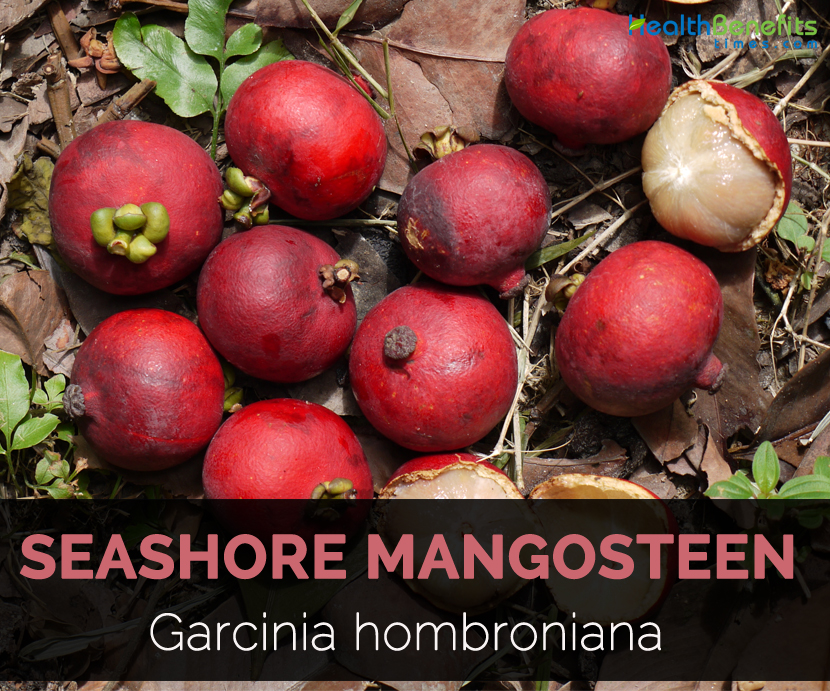| Seashore Mangosteen Quick Facts | |
|---|---|
| Name: | Seashore Mangosteen |
| Scientific Name: | Garcinia hombroniana |
| Origin | Native to Malaysia, Cambodia, Thailand and Vietnam |
| Colors | Pinkish-red or orangey-red |
| Shapes | Smooth, spherical and beaked, 5 cm across |
| Flesh colors | White to creamy-white |
| Taste | Acid-sweet, sour |
Plant description
Seashore Mangosteen is a small and evergreen tree which reaches to the height of 4.6-6 meters but can reach to 30 meters. The trunk is straight with a girth of 180 cm and densely branched. Bark is grey which peels off in little flakes displaying paler grey to buff new bark and has opaque white exudate. Twigs are smooth and green when young but as it becomes older, it turns dark brown and rough. Leaves are coriaceous, glossy, ovate to ovate-oblong and about 15–25 cm long and 5–13 cm wide. Flowers are whitish- cream and tetramerous with four sepals, four petals and pedicellate. Fruit is spherical, beaked, smooth, about 5 cm across with pinkish-red or orangey-red peel crowned by disc like remnant stigma and green leathery calyx at the pedicel end.
Leaves
Leaves are leathery and ranges from light to dark green with underside of leaves lighter than top. Leaves are simple, opposite, elliptical to oval or lanceolate with entire margin. Leaf base is cuneate to obtuse or acute, apex is acute to acuminate with drip tips present. Midrib is formed on both upper and lower surface of the leaf. Glandular lines can be seen on the lower surface of the leaf and wavy brown to pale green lines are angled at around 45 degrees from the midrib.
Flowers
Male and female flowers are dioecious. Usually male flowers occur in the cluster of 2 to 18 and a female flower is solitary and occurs in the cluster of 2 to 3. Flowers are small having four petals which are off white to cream yellow. Sepals are present and inflorescences are terminal arranged in a simple cyme.
Fruit
Fruits are green which turns pinkish-red when mature. They are round with smooth skin and grows upto 5 cm. The smell resembles apple and the pulp is yellowish which tastes sour.
Health Benefits of Seashore Mangosteen
1. Acts as antioxidant
The results of antioxidant activities from all three assays indicated that only compounds 10, 12 and 13 are capable of inhibiting DPPH and ABTS free radicals and also reducing the ferric ions. Compound 10 exhibited strong antioxidant activities followed by compounds 13 and 12. Compound 10, in antioxidant activities was stronger than the positive controls (trolox, gallic acid and ascorbic acid). In DPPH assay, compound 13 showed stronger activities than the standard gallic acid while in ABTS assay it was slightly lower.
2. Combats bacteria
In antibacterial assay, compound 11 (MIC value 31.25 μM) was found to be the most active against Gram positive bacteria (S. aureus and B. Subtilis) followed by compounds 7 (MIC value 62.5 μM) and 10 (MIC value 250.0 μM). Compound 7 exhibited the strongest inhibition against P. aeruginosa; a Gram negative bacterium with MIC value 15.65 μM. The present study reported the isolation of various chemical constituents identified by spectroscopic techniques for the first time from the bark of Seashore Mangosteen. The investigated constituents were analyzed for antioxidant and antibacterial activities. This biochemical investigation study of the isolated compounds justifies the traditional uses of Seashore Mangosteen against infections after child birth and itching problems.
3. Prevention of breast cancer
MEA bark extract of Seashore Mangosteen effective against CCl4-induced liver toxicity and cytotoxic activity against MCF-7 (human breast cancer) and DBTRG (human glioblastoma) cell lines. The results obtained from hepatoprotective activity conducted in the study reports that MEA extract of Seashore Mangosteen at a concentration level of 500 mg/kg significantly debilitiated the increased activity of the blood enzymes. In addition, the 1H and 13C NMR, and IR spectra of the analyzed extract showed characteristic signals of phenolic compounds which can be associated with hepatoprotective and cytotoxic activities.
Traditional uses
- In Malay traditional medicine, it is used for treating various disorders such as gonorrhea, purulence and abdominal pain.
- Roots or leaves decoction is used to provide relief from itching and also used as a protective medicine after childbirth.
- In folk medicine, it is used to provide relief from itchiness.
- Leaf extract has anti-malarial properties.
- Leaves and root decoction is used for trauma, diarrhea and skin allergies.
Culinary uses
- Consume it raw as the pulp has pleasant taste.
- The pulp is used to make jams, juices and jellies.
- Dried rind is used as a sour relish in curries and culinary dishes.
- Fruits are used to make preserves.
References:
https://toptropicals.com/catalog/uid/garcinia_hombroniana.htm
Comments
comments
